| 1. |
cone
scales with prickles (sharp or claw-like nails) on end |
go
to 2 |
|
| 1A. |
cone
scales without prickles or prickles not sharp but dull |
go
to 10 |
|
| 2.
|
cones
large and massive, scales with heavy toenail-like claws at end |
go
to 3 |
|
| 2A. |
cones
not massive looking, scales not as above |
go
to 4 |
|
| 3. |
cones
large and heavy, 9-12 inches, light brown color
Photos by Duncan Wilson and Brother
Alfred Brousseau, St. Mary's College
|
COULTER
PINE |

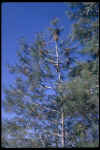
|
| 3A. |
cones
smaller, oval, 5-8 inches, darker brown
Photos by Charles Webber, California
Academy of Sciences and J. E.(Jed) and Bonnie McClellan, California
Academy of Sciences.
|
DIGGER
PINE |

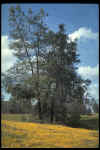
|
| 4. |
prickles
very sharp if cone rubbed with palms top to bottom |
go
to 5 |
|
| 4A. |
prickles
not sharp if cone rubbed with palms |
go
to 6 |
|
| 5. |
cone
large reddish brown, over 5 inches long
Photos by Duncan Wilson, Brother Alfred
Brousseau, St. Mary's College and Robert Potts, California Academy of
Sciences.
|
PONDEROSA
PINE |


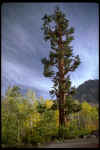
|
| 5A. |
cone
small, light brown, less than 5 inches long
Photos by Brother Alfred Brousseau, St.
Mary's College.
|
BRISTLE
CONE PINE |

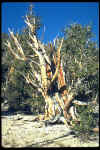
|
| 6. |
cones
smaller than 3 inches, round to oval shape |
go
to 7 |
|
| 6A. |
cones
larger than 3 inches long |
go
to 8 |
|
| 7. |
small
cones with blunt round knobs in center of scale
Photos by Brother Alfred Brousseau, St.
Mary's College
|
PORT
ORFORD CEDAR |

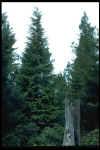
|
| 7A. |
cones
with longer erect knobs on scales |
ALASKA
CEDAR |
|
| 8. |
cones
closed, knobbed on one side only, light gray color
Photos by Charles Webber, California
Academy of Sciences and Brother
Alfred Brousseau, St. Mary's College
|
KNOBCONE
PINE |

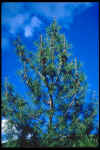
|
| 8A. |
cones
open and symmetrical |
go
to 9 |
|
| 9. |
cones
dark brown, sharp incurved prickle, thin scales |
JEFFERY
PINE |
 |
| 9A. |
cones
lighter brown, dull prickle, scales ending in thick triangle
Photos by Charles Webber, California
Academy of Sciences and Brother Alfred Brousseau, St. Mary's College
|
TORREY
PINE |


|
| 9B. |
cones
scales tipped with a stout, spur-like prickle
Photos by Charles Webber, California
Academy of Sciences and Brother Alfred Brousseau, St. Mary's
College
|
BISHOP
PINE |
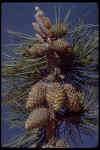

|
| 10. |
cones
with scales with well defined bracts between scales |
go
to 11 |
|
| 10A. |
cone
scales without bracts |
go
to 12 |
|
| 11. |
cones
usually less then 3.5 inches, bracts thin
Photos by Charles Webber, California
Academy of Sciences (fisrt 2) and Brother
Alfred Brousseau, St. Mary's College
|
DOUGLAS
FIR |



|
| 11A. |
cones
usually over 5 inches, rounded scales, bracts |
BIG
CONE DOUGLAS FIR |
 |
| 12. |
scales
thin and flaky |
go
to 13 |
|
| 12A. |
scales
not thin and flaky |
go
to 14 |
|
| 13. |
scales
tightly wound around cone, purplish or dark brown color
Photos by J. E.(Jed) and Bonnie
McClellan, California Academy of Sciences and Brother
Alfred Brousseau, St. Mary's College.
|
TRUE
CEDARS, LARCH, WHITE FIR |
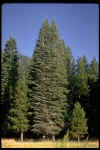

|
| 13A. |
scales
loose, papery thin, light brown
Photos by Brother Alfred Brousseau, St.
Mary's College and Robert Potts, California Academy of Sciences
|
SITKA
SPRUCE |
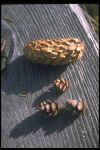

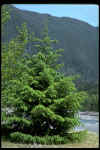
|
| 14. |
cones
small, less than 3 inches tall |
go
to 15 |
|
| 14A. |
cones
much larger then 3 inches tall |
go
to 16 |
|
| 15. |
cones
with thick blunt scales, taller then wide
Photos by credit Charles Webber,
California Academy of Sciences and Dorothy Judd, California Academy
of Sciences.
|
SEQUOIA |

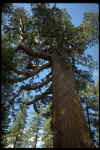
|
| 15A. |
cones
wider then tall and squatty-looking |
PINYON
PINE |
 |
| 15B. |
cones
less then 2 inches, oval-shape, blunt scales |
REDWOOD |
 |
| 16. |
cones
oval, chocolate brown, diamond on end of scales
Photos by Charles Webber, California
Academy of Sciences and Brother Alfred Brousseau, St. Mary's College
|
MONTEREY
PINE |
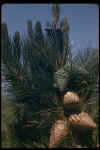
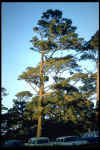
|
| 16A. |
cones
without diamond on end of scales |
go
to 17 |
|
| 17. |
very
large cone, greater then 10 inches long, flat scales
Photos by Duncan Wilson and Brother
Alfred Brousseau, St. Mary's College
|
SUGAR
PINE |

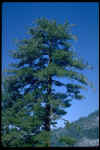
|
| 17A. |
cones
smaller, end of scale larger then rest of scale
Photos by Brother Alfred Brousseau, St.
Mary's College and Neva Snell, California Academy of Sciences
|
WESTERN
WHITE PINE |

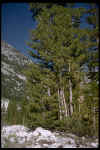
|